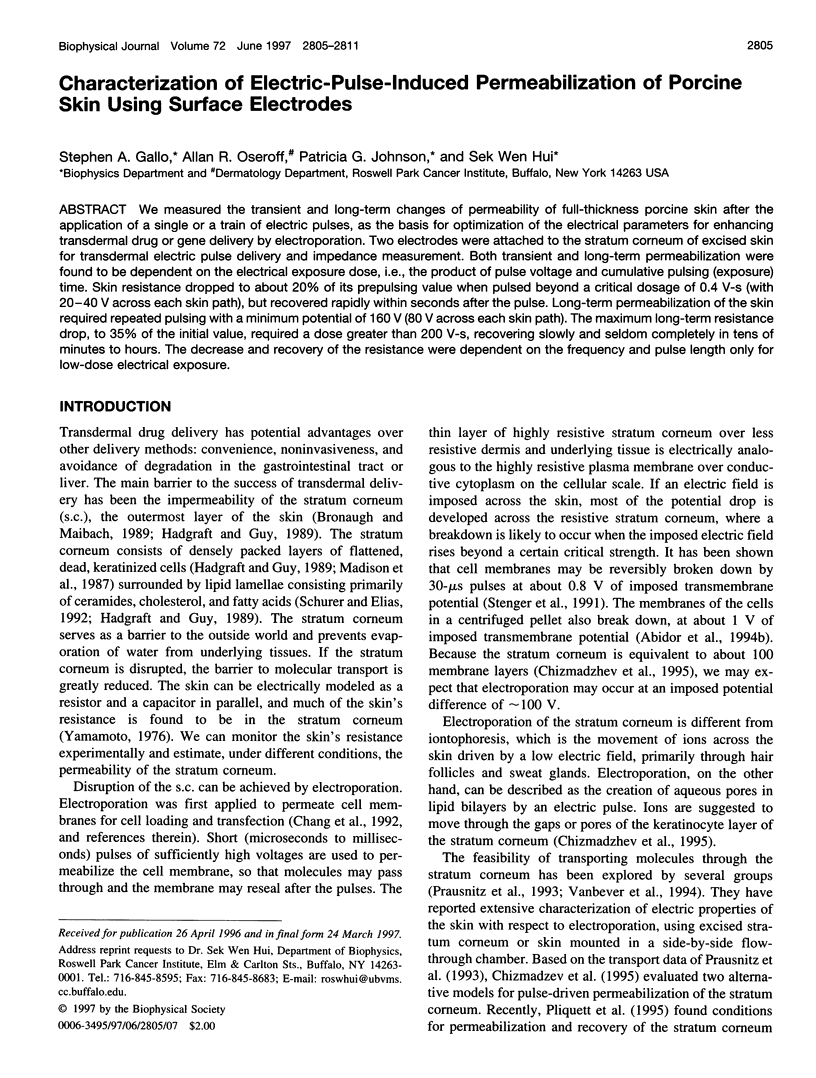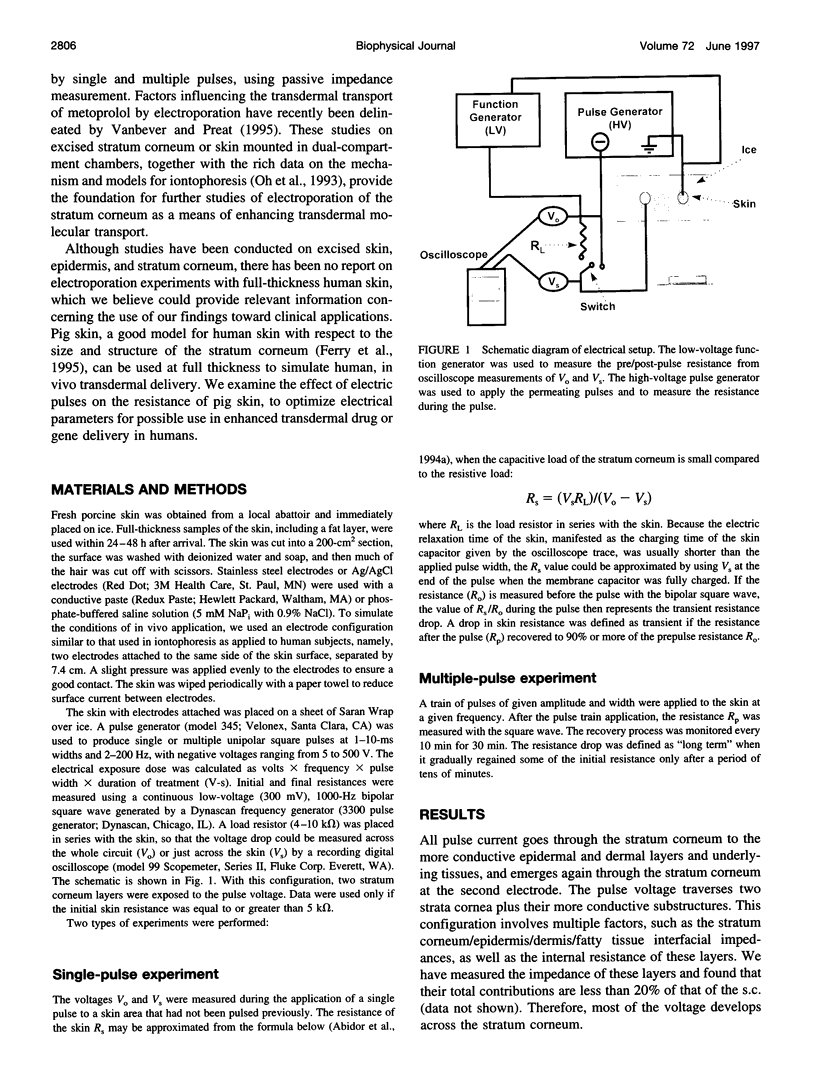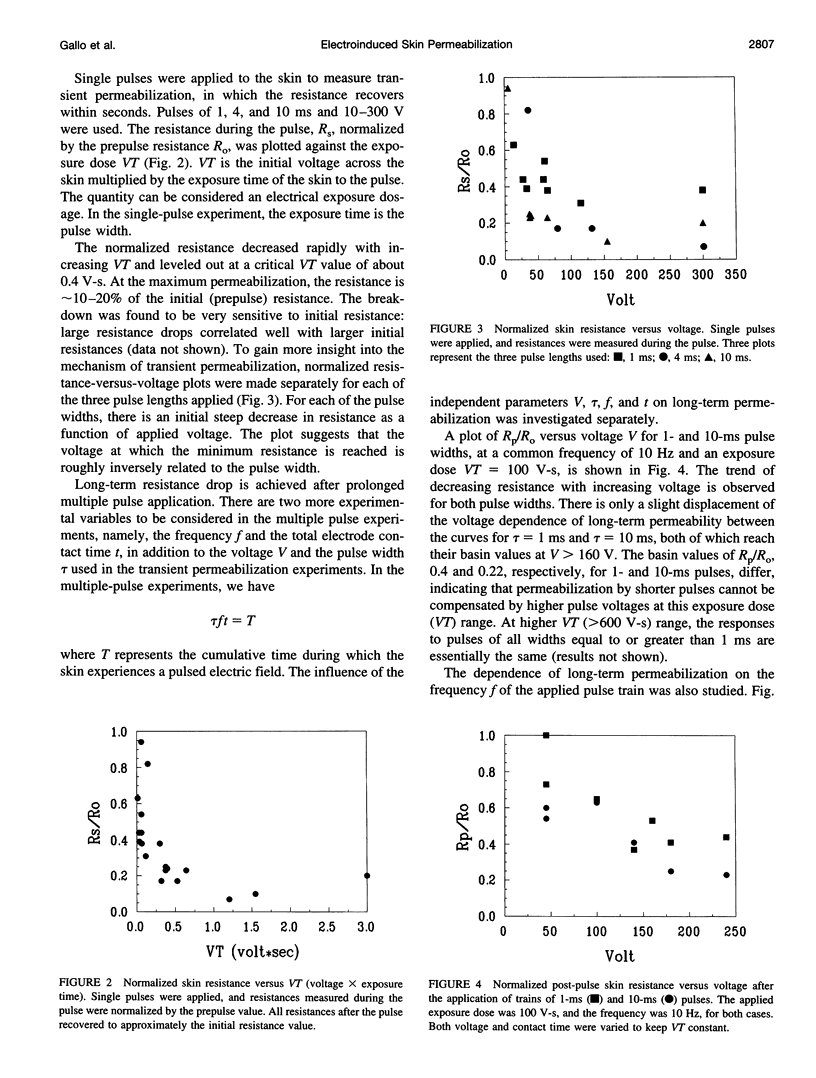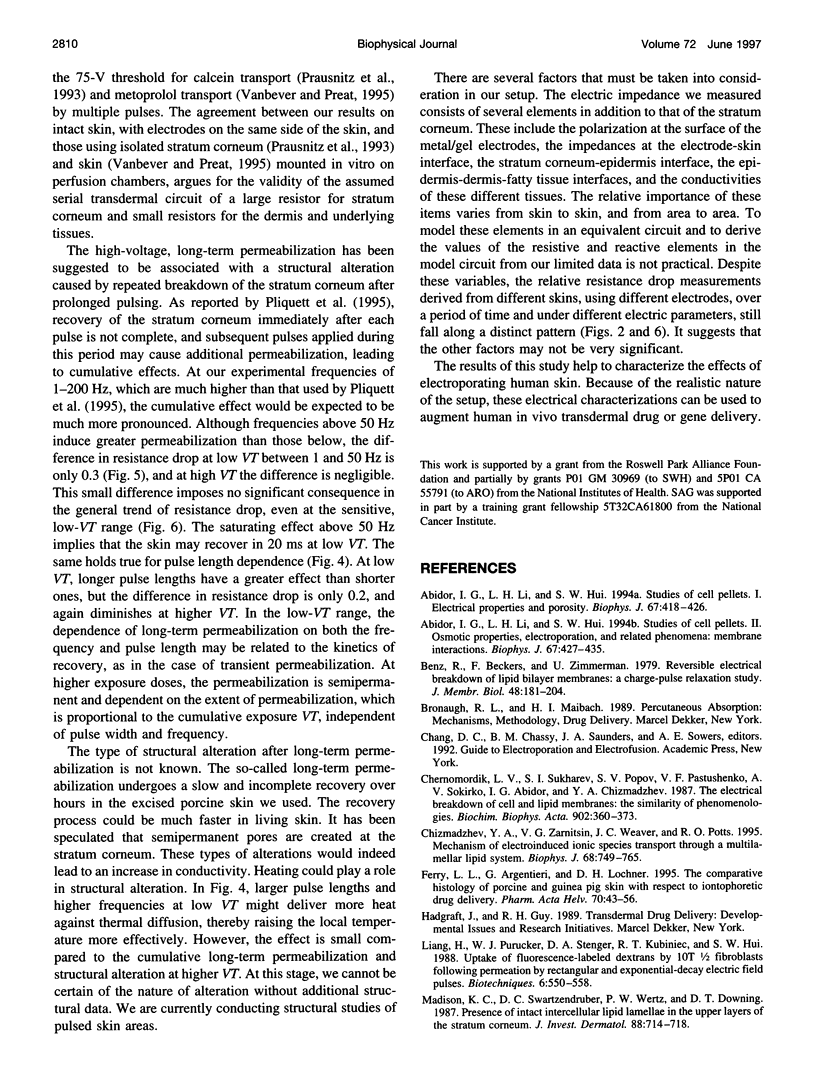Abstract
We measured the transient and long-term changes of permeability of full-thickness porcine skin after the application of a single or a train of electric pulses, as the basis for optimization of the electrical parameters for enhancing transdermal drug or gene delivery by electroporation. Two electrodes were attached to the stratum corneum of excised skin for transdermal electric pulse delivery and impedance measurement. Both transient and long-term permeabilization were found to be dependent on the electrical exposure dose, i.e., the product of pulse voltage and cumulative pulsing (exposure) time. Skin resistance dropped to about 20% of its prepulsing value when pulsed beyond a critical dosage of 0.4 V-s (with 20-40 V across each skin path), but recovered rapidly within seconds after the pulse. Long-term permeabilization of the skin required repeated pulsing with a minimum potential of 160 V (80 V across each skin path). The maximum long-term resistance drop, to 35% of the initial value, required a dose greater than 200 V-s, recovering slowly and seldom completely in tens of minutes to hours. The decrease and recovery of the resistance were dependent on the frequency and pulse length only for low-dose electrical exposure.
Full text
PDF






Images in this article
Selected References
These references are in PubMed. This may not be the complete list of references from this article.
- Abidor I. G., Li L. H., Hui S. W. Studies of cell pellets: I. Electrical properties and porosity. Biophys J. 1994 Jul;67(1):418–426. doi: 10.1016/S0006-3495(94)80497-7. [DOI] [PMC free article] [PubMed] [Google Scholar]
- Abidor I. G., Li L. H., Hui S. W. Studies of cell pellets: II. Osmotic properties, electroporation, and related phenomena: membrane interactions. Biophys J. 1994 Jul;67(1):427–435. doi: 10.1016/S0006-3495(94)80498-9. [DOI] [PMC free article] [PubMed] [Google Scholar]
- Benz R., Beckers F., Zimmermann U. Reversible electrical breakdown of lipid bilayer membranes: a charge-pulse relaxation study. J Membr Biol. 1979 Jul 16;48(2):181–204. doi: 10.1007/BF01872858. [DOI] [PubMed] [Google Scholar]
- Chernomordik L. V., Sukharev S. I., Popov S. V., Pastushenko V. F., Sokirko A. V., Abidor I. G., Chizmadzhev Y. A. The electrical breakdown of cell and lipid membranes: the similarity of phenomenologies. Biochim Biophys Acta. 1987 Sep 3;902(3):360–373. doi: 10.1016/0005-2736(87)90204-5. [DOI] [PubMed] [Google Scholar]
- Chizmadzhev Y. A., Zarnitsin V. G., Weaver J. C., Potts R. O. Mechanism of electroinduced ionic species transport through a multilamellar lipid system. Biophys J. 1995 Mar;68(3):749–765. doi: 10.1016/S0006-3495(95)80250-X. [DOI] [PMC free article] [PubMed] [Google Scholar]
- Ferry L. L., Argentieri G., Lochner D. H. The comparative histology of porcine and guinea pig skin with respect to iontophoretic drug delivery. Pharm Acta Helv. 1995 Apr;70(1):43–56. doi: 10.1016/0031-6865(94)00050-6. [DOI] [PubMed] [Google Scholar]
- Liang H., Purucker W. J., Stenger D. A., Kubiniec R. T., Hui S. W. Uptake of fluorescence-labeled dextrans by 10T 1/2 fibroblasts following permeation by rectangular and exponential-decay electric field pulses. Biotechniques. 1988 Jun;6(6):550-2, 554, 556-8. [PubMed] [Google Scholar]
- Madison K. C., Swartzendruber D. C., Wertz P. W., Downing D. T. Presence of intact intercellular lipid lamellae in the upper layers of the stratum corneum. J Invest Dermatol. 1987 Jun;88(6):714–718. doi: 10.1111/1523-1747.ep12470386. [DOI] [PubMed] [Google Scholar]
- Pliquett U., Langer R., Weaver J. C. Changes in the passive electrical properties of human stratum corneum due to electroporation. Biochim Biophys Acta. 1995 Nov 1;1239(2):111–121. doi: 10.1016/0005-2736(95)00139-t. [DOI] [PubMed] [Google Scholar]
- Prausnitz M. R., Bose V. G., Langer R., Weaver J. C. Electroporation of mammalian skin: a mechanism to enhance transdermal drug delivery. Proc Natl Acad Sci U S A. 1993 Nov 15;90(22):10504–10508. doi: 10.1073/pnas.90.22.10504. [DOI] [PMC free article] [PubMed] [Google Scholar]
- Schurer N. Y., Elias P. M. The biochemistry and function of stratum corneum lipids. Adv Lipid Res. 1991;24:27–56. doi: 10.1016/b978-0-12-024924-4.50006-7. [DOI] [PubMed] [Google Scholar]
- Stenger D. A., Kaler K. V., Hui S. W. Dipole interactions in electrofusion. Contributions of membrane potential and effective dipole interaction pressures. Biophys J. 1991 May;59(5):1074–1084. doi: 10.1016/S0006-3495(91)82322-0. [DOI] [PMC free article] [PubMed] [Google Scholar]
- Vanbever R., Lecouturier N., Préat V. Transdermal delivery of metoprolol by electroporation. Pharm Res. 1994 Nov;11(11):1657–1662. doi: 10.1023/a:1018930425591. [DOI] [PubMed] [Google Scholar]
- Yamamoto T., Yamamoto Y. Electrical properties of the epidermal stratum corneum. Med Biol Eng. 1976 Mar;14(2):151–158. doi: 10.1007/BF02478741. [DOI] [PubMed] [Google Scholar]



